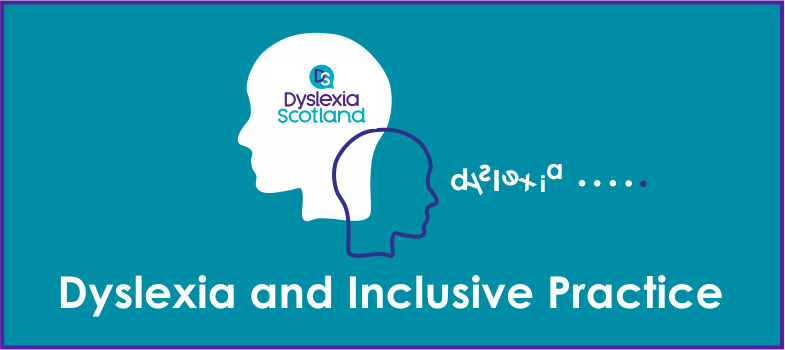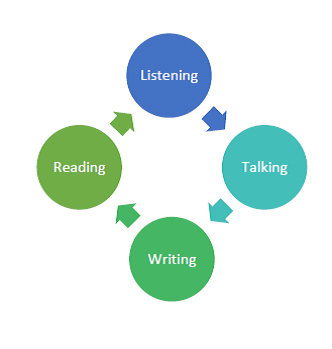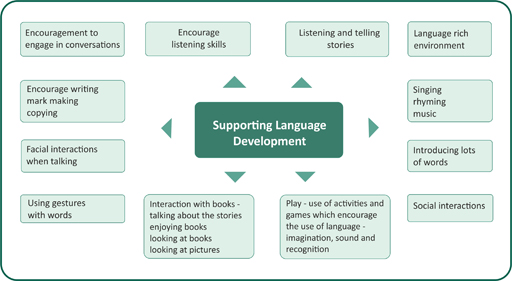2.6. Language development
“Our ability to use language is central to our thinking, our learning and our personal development. Literacy and language unlock access to the wider curriculum and lay the foundations for communication, lifelong learning and work, contributing strongly to the development of all four capacities of Curriculum for Excellence”.
Research has highlighted the importance of positive influences in the early years in improving a child’s life chances.
There is a strong relationship between early life experiences and how children learn. Inequalities experienced by parents and children can affect speech, language and communication development and lead to further inequalities later in life. These early learning experiences are vital in forming the building blocks from which more formal literacy learning can be developed. A literacy rich environment promotes, supports and enriches listening, talking, reading and writing. This is shown in Figure 17. This approach models high standards and sets high expectations for literacy.
The Scottish Government 2010 Literacy Action Plan [Tip: hold Ctrl and click a link to open it in a new tab. (Hide tip)] highlights that literacy starts from birth and in the very early years. The home learning environment for children from birth to 3 years old has a significant impact on cognitive and language development. Parents, irrespective of socio-economic group or where they live, can make a real difference to their children's outcomes by talking to them, playing with them and ensuring they engage in different experiences. Interacting with and providing stimulating environments for young children helps to put in place the building blocks for their growth and development. Communication and engaging with books from an early age are crucial to speech and language development. Extensive research has highlighted the positive impact of reading to children in their pre-school years. Previously published ‘Growing Up in Scotland’ data has shown that children who are frequently read to in the first year of life score higher in assessments of cognitive ability at age 3-4 years old. This suggests that in the very early years the home learning environment for children from birth to 3 years old has a significant impact on cognitive and language development.
Activity 16
As children grow towards primary school age, their social, emotional, physical and educational wellbeing build upon foundations laid in earlier years and continue to be influenced by their home environment and their relationship with their parents. Before formal education can begin, a range of skills should ideally be learnt by the children. Consider what you think these are and click the ‘Reveal discussion’ button for the answer.
Discussion
Before formal education can begin, children must learn to:
- Play
- Talk
- Listen
- Understand
- Attend
Figure 18 highlights helpful approaches which can support good language development in young children. A range of resources have been developed by Allied Health Professions for example speech and language therapists to highlight the expected language developmental milestones.
Select here to access the Milestones to support learners with complex needs.
To support the development of language and numeracy skills for children in Primary 1–3, the Scottish Government is leading a campaign which focuses on key skills among children called Read, Write and Count. This campaign is aimed at encouraging and supporting parents and families in the key role they play in helping their children to read, write and count well. The approach is to incorporate reading, writing and counting into their everyday activities, such as walking around the supermarket or travelling home from school.
The campaign builds on the Scottish Government’s PlayTalk Read early years campaign and is being delivered in partnership with Education Scotland and The Scottish Book Trust over 3 years. It builds on relevant established frameworks which include Curriculum for Excellence and Raising Attainment for All and aims to tackle educational inequalities and raise attainment in early years and beyond.
For more information and resources on Read, Write, Count, visit www.readwritecount.scot.
Education Scotland have published the Primary One Literacy Assessment and Action Resource (POLAAR) that is designed to support improvement by helping Primary 1 teachers identify and assess children who are most at risk of developing later difficulties with reading and writing.
It is based on a staged intervention model of ‘observe-action-observe’, which helps identify the most effective intervention to take at classroom and child levels.
Although the POLAAR resources focus on primary one, the resources within the pack, such as the literature reviews, are helpful for practitioners working with learners at any stage who have a literacy difficulty, including those in secondary school.
Select here to access the POLAAR resources
Activity 17
To support a learner to improve their literacy skills it is essential to develop an understanding of the learner’s consolidated
- Pre and early phonological skills
- Knowledge of the alphabet, including sequencing and names and sounds of letters.
The links below will take you to free early literacy assessments on the Addressing Dyslexia Toolkit and Education Scotland websites:
In your Reflective Log, record your experience of learning about these resources and the impact of them when used with learners.
Now try the Formative quiz 1 to consolidate your knowledge and understanding from this section. Completing the quizzes is part of gaining the digital badge, as explained in the module overview.
2.5. Dyslexia and literacy



